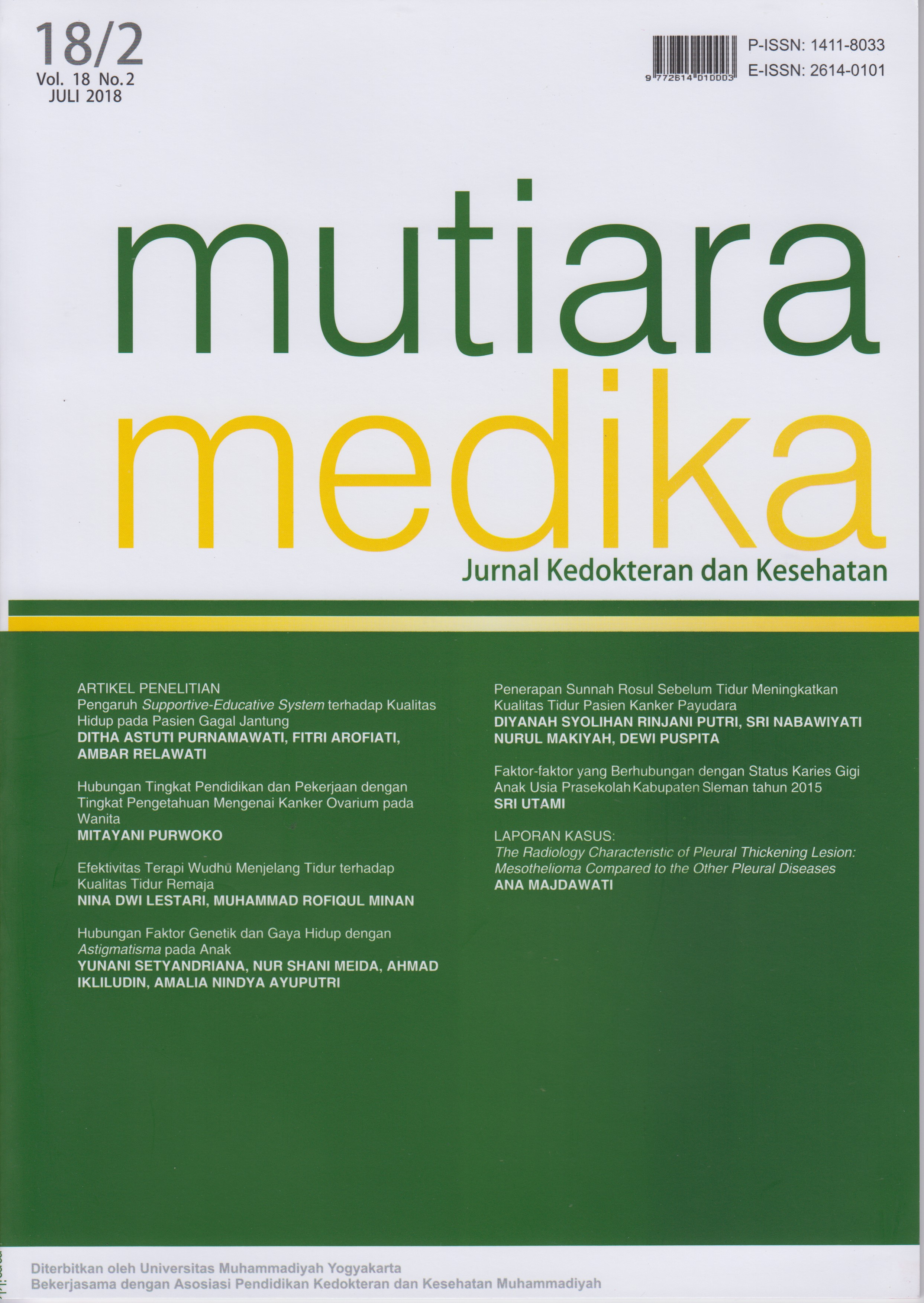Faktor-faktor yang Berhubungan dengan Status Karies Gigi Anak Usia Prasekolah Kabupaten Sleman Tahun 2015
DOI:
https://doi.org/10.18196/mm.180218Keywords:
Faktor risiko karies, usia prasekolah, indeks def-sAbstract
Karies gigi anak merupakan masalah utama di negara-negara sedang berkembang. Prevalensi karies gigi anak usia 3-6 tahun di Kota Yogyakarta mencapai 84,1%. Karies gigi merupakan multifactorial desease, antara lain faktor host, agent dan lingkungan mulut. Tujuan penelitian ini adalah untuk mengetahui hubungan pH saliva, plak gigi, frekuensi menyikat gigi dengan status karies gigi anak usia prasekolah. Jenis penelitian ini adalah observasional dengan case control study. Subyek penelitian adalah 80 anak-anak usia 4-6 tahun di TK wilayah Kabupaten Sleman. Teknik sampling yang digunakan adalah purposive sampling. Status karies gigi diukur menggunakan indeks def-s, plak gigi diukur menggunakan indeks PHP-M dan pH saliva diukur menggunakan pH digital meter, serta frekuensi menyikat gigi diukur menggunakan kuesioner. Analisis data yang digunakan adalah logistic regression. Hasil analisis multivariat menunjukkan bahwa plak gigi berhubungan dengan status karies gigi dengan OR = 4,3 dan p = 0,015, pH saliva dengan OR = 6,2 dan p = 0,002 dan frekuensi menyikat gigi dengan OR = 6,5 dan p = 0,002. Plak gigi, pH saliva dan frekuensi menyikat gigi merupakan faktor risiko yang berhubungan dengan status karies gigi anak usia prasekolah. Frekuensi menyikat gigi merupakan faktor risiko yang paling berperan dalam kejadian karies gigi anak usia prasekolah.
References
Moses JM, Rangeeth BN dan Gurunathan D. Prevalence of Dental Caries, Socio-Economic Status and Treatment Needs among 5 to 15 Year Old School Going Children of Chidambaran. J Clin Diagnostic Res, 2011; 5 (1): 146-151.
Petersen PE, Bourgeois D, Ogawa H, Estupinan-Day S dan Ndiaye C. The Global Burden of Oral Disease and Risk to Oral Health. Bulletin of The World Health Organization, 2005; 83: 661-669.
Depoala DP, Clakrson JJ, Gluch JI, Roach K dan Wang X. Update on Early Childhood Caries. The Colgate Oral Care Report, 2010; 20 (2): 1-3.
Borutta A, Wagner M dan Kneist S. Early Childhood Caries: A Multi-Factorial Disease. OHDMBSC, 2010; 9 (1): 32-38.
Pretty IA. Caries Detection and Diagnosis: Novel Technologies. Journal of Dentistry, 2006; 34: 727-739.
Dawes C. What Is Tha Critical pH and Why Does A Tooth Dissolve in Acid?.J Cand Dent Assoc, 2003; 69 (11): 722-724.
7.Murti, B., (1997), Prinsip dan Metode Riset Epidemiologi, Gadjah Mada University Press.
Zafar S, Harnekar SY dan Siddiqi A. Early Childhood Caries: Etiology, Clinical Considerations, Consequences and Management. International Dentistry SA, 2006; 11 (4): 24-36.
Marsh PD. Dental Plaque as A Biofilm: The Significance of pH in Health and Caries. Continuing Education, 2009; 30 (2): 76-87.
Riyanti E. Pengenalan dan Perawatan Kesehatan Gigi Anak Sejak Dini. Seminar Sehari Kesehatan Psikologi Anak. 2005.
Shimizu K, Igarashi K dan Takahashi N. Chairside Evaluation of pH Lowering Activity and Lactic Acid Production of Dental Plaque: Correlation with Caries Experience and Incidence in Preschool Children. Quintessence International, 2008; 30 (2): 151-158.
Schroth RJ, Brothwell DJ dan Moffatt MEK. Caregiver Knowledge and Attitudes of Preschool Oral Health and Early Childhood Caries (ECC). Int J Circumpolar Health, 2007; 66 (2): 153-167.
Finlayson TL, Siefert K, Ismail AL dan Sohn W. Maternal Self Efficacy and 1-5 Year Old Children’s Brushing Habits. Community Dent Oral Epidemiol, 2007; 35 (4): 272-281.
Owen SA, Gansky SA, Platt LJ, Weintraub JA, Soobader MJ, Bramlett MD, et al. Influences on Children’s Oral Health: A Conceptual Model. Pediatrics, 2007; 120 (3): 510-520
Downloads
Published
Issue
Section
License
Copyright
Authors retain copyright and grant Mutiara Medika: Jurnal Kedokteran dan Kesehatan (MMJKK) the right of first publication with the work simultaneously licensed under an Attribution 4.0 International (CC BY 4.0) that allows others to remix, adapt and build upon the work with an acknowledgment of the work's authorship and of the initial publication in Mutiara Medika: Jurnal Kedokteran dan Kesehatan (MMJKK).
Authors are permitted to copy and redistribute the journal's published version of the work (e.g., post it to an institutional repository or publish it in a book), with an acknowledgment of its initial publication in Mutiara Medika: Jurnal Kedokteran dan Kesehatan (MMJKK).
License
Articles published in the Mutiara Medika: Jurnal Kedokteran dan Kesehatan (MMJKK) are licensed under an Attribution 4.0 International (CC BY 4.0) license. You are free to:
- Share — copy and redistribute the material in any medium or format.
- Adapt — remix, transform, and build upon the material for any purpose, even commercially.
This license is acceptable for Free Cultural Works. The licensor cannot revoke these freedoms as long as you follow the license terms. Under the following terms:
Attribution — You must give appropriate credit, provide a link to the license, and indicate if changes were made. You may do so in any reasonable manner, but not in any way that suggests the licensor endorses you or your use.
- No additional restrictions — You may not apply legal terms or technological measures that legally restrict others from doing anything the license permits.






